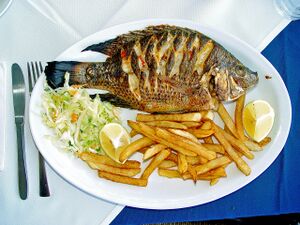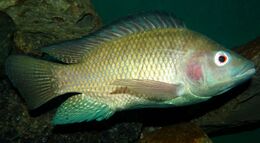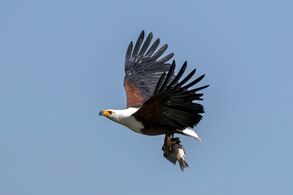بلطي (سمك)
البلطي (إنگليزية: Tilapia)، هو الاسم الشائع لما يقارب مائة نوع من أسماك الفصيلة البلطية from the coelotilapine, coptodonine, heterotilapine, oreochromine, pelmatolapiine, and tilapiine tribes (formerly all were "Tilapiini"), with the economically most important species placed in the Coptodonini and Oreochromini.[2] Tilapia are mainly freshwater fish inhabiting shallow streams, ponds, rivers, and lakes, and less commonly found living in brackish water. Historically, they have been of major importance in artisanal fishing in Africa, and they are of increasing importance in aquaculture and aquaponics. Tilapia can become a problematic invasive species in new warm-water habitats such as Australia,[3] whether deliberately or accidentally introduced, but generally not in temperate climates due to their inability to survive in cold water.
Tilapia is the fourth-most consumed fish in the United States dating back to 2002. The popularity of tilapia came about due to its low price, easy preparation, and mild taste.[4]
. . . . . . . . . . . . . . . . . . . . . . . . . . . . . . . . . . . . . . . . . . . . . . . . . . . . . . . . . . . . . . . . . . . . . . . . . . . . . . . . . . . . . . . . . . . . . . . . . . . . . . . . . . . . . . . . . . . . . . . . . . . . . . . . . . . . . . . . . . . . . . . . . . . . . . . . . . . . . . . . . . . . . . . .
التاريخ

The aquaculture of Nile tilapia goes back to Ancient Egypt, where it was represented by the hieroglyph K1, of the Gardiner list: 𓆛
Tilapia was a symbol of rebirth in Egyptian art, and was in addition associated with Hathor. It was also said to accompany and protect the sun god on his daily journey across the sky. Tilapia painted on tomb walls, is reminiscient of spell 15 of the Book of the Dead by which the deceased hopes to take his place in the sun boat: "You see the tilapia in its [true] form at the turquoise pool", and "I behold the tilapia in its [true] nature guiding the speedy boat in its waters."[5]
Tilapia were one of the three main types of fish caught in Talmudic times from the Sea of Galilee, specifically the Galilean comb (Sarotherodon galilaeus). Today, in Modern Hebrew, the fish species is called amnoon (probably a compound of am, "mother" and noon, "fish"). In English, it is sometimes known by the name "St. Peter's fish", which comes from the story in the Gospel of Matthew about the apostle Peter catching a fish that carried a coin in its mouth, though the passage does not name the fish.[6] While the name also applies to Zeus faber, a marine fish not found in the area, a few tilapia species (Sarotherodon galilaeus, Oreochromis aureus, Coptodon zillii, and Tristramella) are found in the Sea of Galilee, where the author of the Gospel of Matthew recounts the event took place. These species have been the target of small-scale artisanal fisheries in the area for thousands of years.[7][8]
الخصائص
الأنواع
الأنواع الغريبة والغازية
الأنواع البحرية
| هذا المقال هو جزء من سلسلة عن |
| الأسماك التجارية |
|---|
| الكبيرة بأعالي البحار |
| الفريسة |
| Demersal |
| مختلط |
الأنواع التجارية
| أنواع أسماك البلطي التجاري | ||||||||||
|---|---|---|---|---|---|---|---|---|---|---|
| الاسم الشائع | الاسم العلمي | أقصى طول |
الطول الشائع |
أقصى وزن |
أقصى عمر |
المستوى [[Trophic level|الغذائي |
قاعدة السمكة |
الفاو | WoRMS | وضع الحفاظ |
| البلطي النيلي | Oreochromis niloticus (Linnaeus, 1758) | 60 cm | cm | 4.324 kg | 9 years | 2.0 | [9] | [10][11] | [12] | Not assessed |
| البلطي الأزرق | - Oreochromis aureus (Steindachner, 1864) |
45.7 cm | 16 cm | 2.010 kg | years | 2.1 | [13] | [14] | Not assessed | |
| هجين البلطي النيلي والأزرق | cm | cm | kg | years | ||||||
| بلطي موزمبيق | Oreochromis mossambicus (Peters, 1852) | 39 cm | 35 cm | 1.130 kg | 11 years | 2.0 | [15] | [16] | [17] | |
المزارع السمكية
كغذاء


استخدامات متفرقة
. . . . . . . . . . . . . . . . . . . . . . . . . . . . . . . . . . . . . . . . . . . . . . . . . . . . . . . . . . . . . . . . . . . . . . . . . . . . . . . . . . . . . . . . . . . . . . . . . . . . . . . . . . . . . . . . . . . . . . . . . . . . . . . . . . . . . . . . . . . . . . . . . . . . . . . . . . . . . . . . . . . . . . . .
الأمراض
انظر أيضاً
معرض الصور
Men fishing for tilapia
Lake Naivasha, KenyaGiant kingfisher with tilapia
Lake NaivashaAfrican fish eagle with tilapia
Lake Naivasha
المصادر
- ^ Fisheries and Aquaculture Department Statistics UN Food and Agriculture Department
- ^ Andreas R.Dunz & Ulrich K.Schliewen (2013). "Molecular phylogeny and revised classification of the haplotilapiine cichlid fishes formerly referred to as Tilapia". Molecular Phylogenetics and Evolution. 68 (1): 64–80. doi:10.1016/j.ympev.2013.03.015. PMID 23542002.
- ^ "Tilapia". Department of Agriculture, Fisheries and Forestry.
- ^ "Tilapia | Seafood Health Facts". www.seafoodhealthfacts.org. Retrieved 2017-02-01.
- ^ Gay Robin: Women in ancient Egypt (p. 188), British museum press, 1993, ISBN 0-7141-0956-8
- ^ Matthew 17:24–27
- ^ Baker, Jenny (1988). Simply Fish. London: Faber & Faber. p. 197. ISBN 0-571-14966-9.
- ^ Rosencrans, Joyce (2003-07-16). "Tilapia is a farmed fish of biblical fame". The Cincinnati Post. E. W. Scripps Company. Archived from the original on 2006-02-18. Retrieved 2012-09-15.
- ^ "Oreochromis niloticus". FishBase. Ed. Ranier Froese and Daniel Pauly. September 2012 version. N.p.: FishBase, 2012.
- ^ "Oreochromis niloticus Linnaeus, 1758)". Species Fact Sheet. Food and Agriculture Organization of the United Nations. Retrieved 2012-09-15.
- ^ خطأ استشهاد: وسم
<ref>غير صحيح؛ لا نص تم توفيره للمراجع المسماةFAONileTilapia - ^ "Oreochromis niloticus". WoRMS. World Register of Marine Species. Retrieved 2012-09-15.
- ^ "Oreochromis aureus". FishBase. Ed. Ranier Froese and Daniel Pauly. September 2012 version. N.p.: FishBase, 2012.
- ^ "Oreochromis aureus". WoRMS. World Register of Marine Species. Retrieved August 12, 2017.
- ^ "Oreochromis mossambicus". FishBase. Ed. Ranier Froese and Daniel Pauly. September 2012 version. N.p.: FishBase, 2012.
- ^ "Oreochromis mossambicus (Peters, 1852)". Species Fact Sheet. Food and Agriculture Organization of the United Nations. Retrieved August 12, 2017.
- ^ "Oreochromis mossambicus (Peters, 1852)". WoRMS. World Register of Marine Species. Retrieved August 12, 2017.
- ^ Herdson D, Priede I (2011). "Oreochromis mossambicus". IUCN Red List of Threatened Species. 2011. Retrieved August 12, 2017.
- ^ خطأ استشهاد: وسم
<ref>غير صحيح؛ لا نص تم توفيره للمراجع المسماةfaostat
قراءات إضافية
- Logan, Cheryl A.; Alter, S. Elizabeth; Haupt, Alison J.; Tomalty, Katharine; Palumbi, Stephen R. (2008). "An impediment to consumer choice: Overfished species are sold as Pacific red snapper". Biological Conservation. 141 (6): 1591–1599. doi:10.1016/j.biocon.2008.04.007. ISSN 0006-3207.
- FAO Fishery Information, Data & Statistics Service (1993). "Aquaculture production (1985-1991)". FAO Fisheries Circular. Food and Agriculture Organization of the United Nations. 815: 20–21.
- Trewavas, Ethelwynn (1983). Tilapiine fish of the genera Sarotherodon, Oreochromis and Danakilia. London: British Museum (Natural History). ISBN 0-565-00878-1.
- McCrary, Jeffrey K; Castro, Mark; McKaye, Kenneth R. (2005). "Mercury in Fish From Two Nicaraguan Lakes: A Recommendation for Increased Monitoring of Fish for International Commerce" (PDF). Environmental Pollution. pp. 513–518. Archived from the original (PDF) on 2011-10-03.
وصلات خارجية
- Cite iucn maint
- Articles containing إنگليزية-language text
- Pages using Lang-xx templates
- Articles with hatnote templates targeting a nonexistent page
- Portal-inline template with redlinked portals
- Pages with empty portal template
- أسماك البلطي
- أسماك تجارية
- أسماء أسماك شائعة
- مطبخ فلپيني
- أسماك الفلپين
- أسماك مصر
- مطبخ مصري













